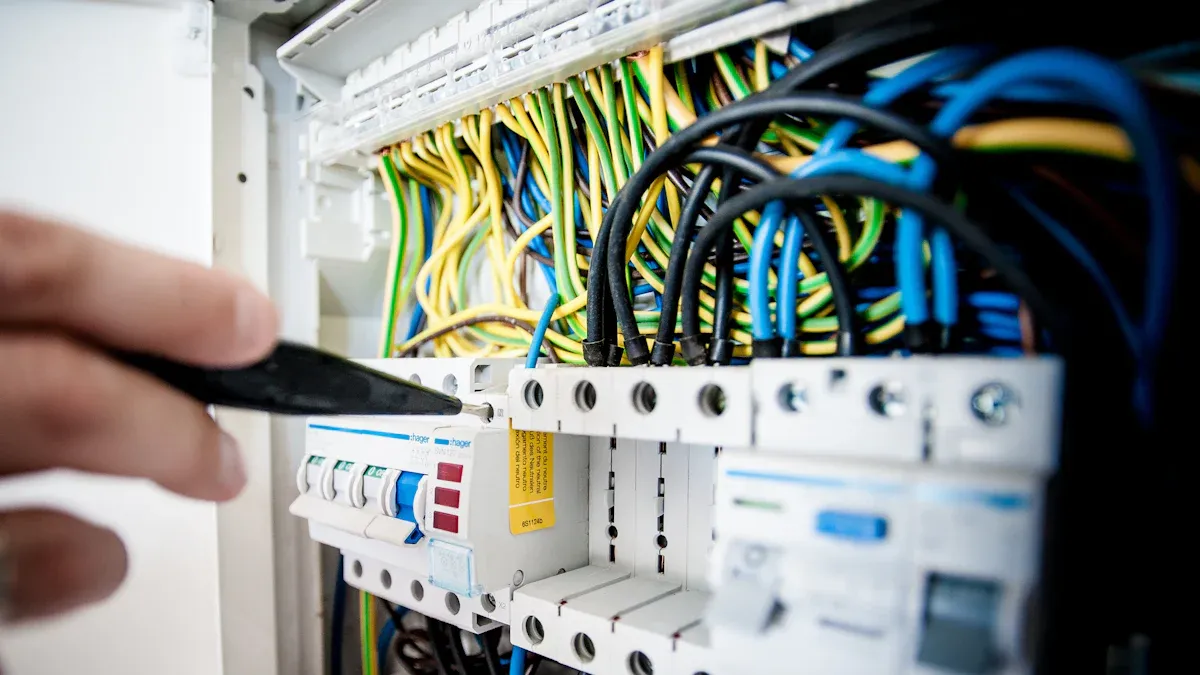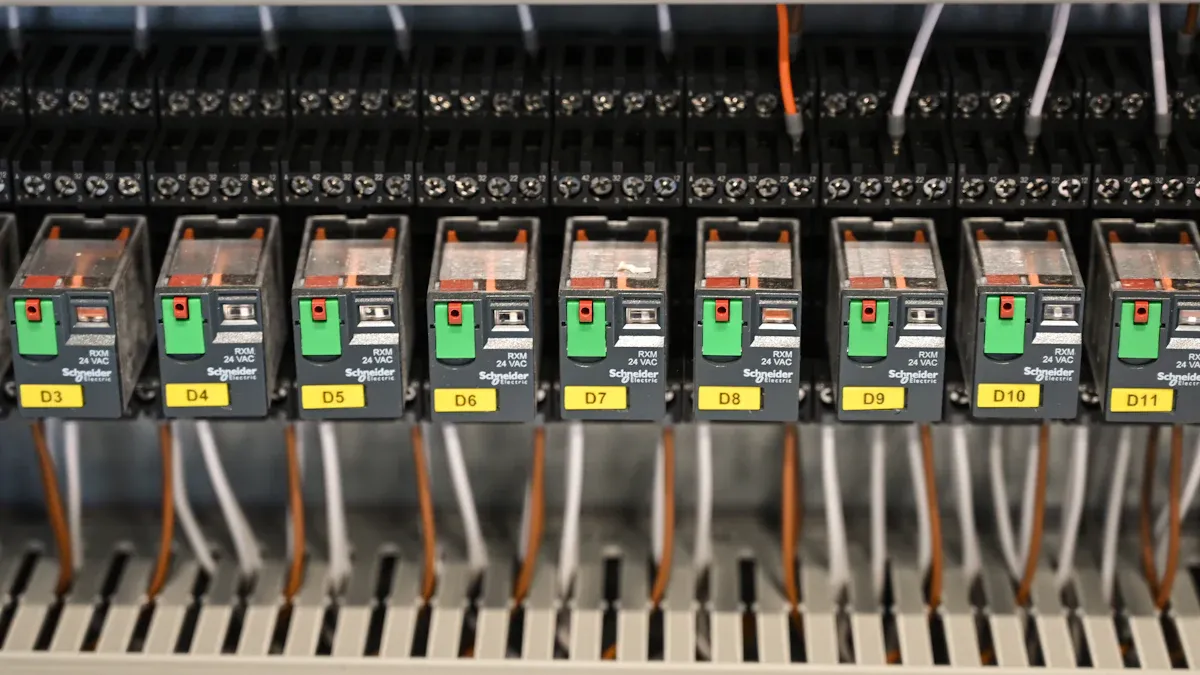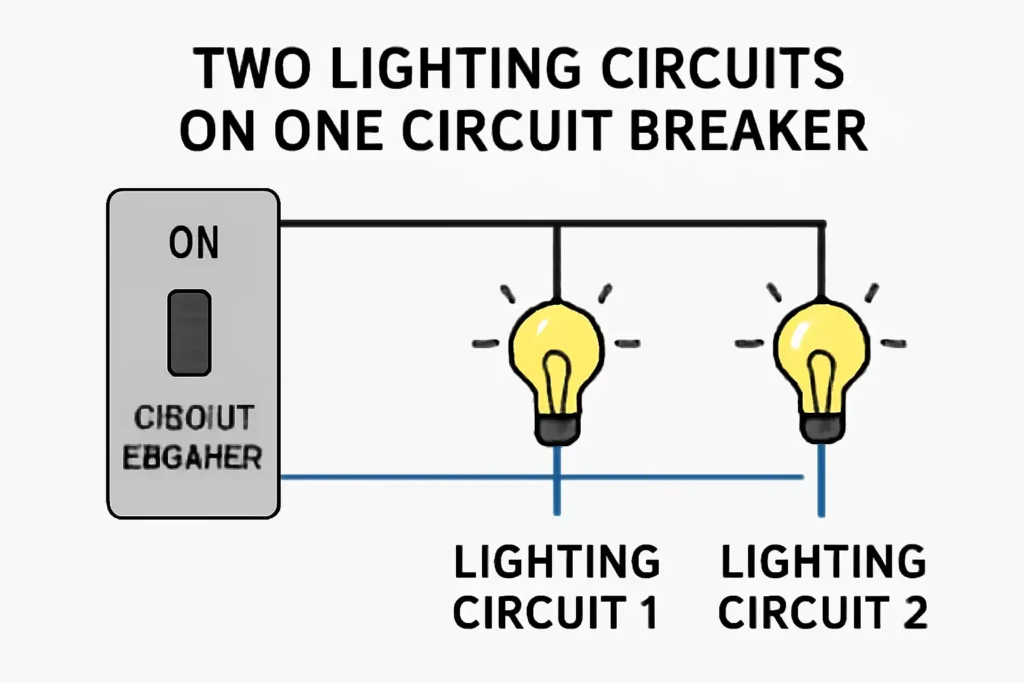You can put two lighting circuits on one circuit breaker. But, you must check some important things first.
- Look at the circuit breaker’s capacity.
- Electrical rules say not to use over 80% of its limit.
For example:
- A 15-amp circuit breaker can safely handle up to 12 amps.
- If the total load is 11.2 amps, the circuit breaker needs at least 14 amps.
The National Electrical Code (NEC) says, “terminals for more than one conductor shall be so identified.” This helps with correct setup and stops wiring problems.
Follow these rules to avoid overloading and keep your system safe.
Key Takeaways
- You can put two lighting circuits on one breaker. First, check the breaker’s capacity. Use only 80% of its limit to stay safe.
- If a breaker is overloaded, it might trip or cause fires. Always add up the total load before combining circuits.
- Follow the National Electrical Code (NEC) rules. Label wires clearly to avoid errors and stay safe.
- Using separate breakers for each circuit is a good idea. It makes fixing problems easier and lowers the chance of overloads.
- Ask a licensed electrician for help. They can make sure your setup is safe and follows local rules.
Safety Considerations

Risks of Overloading a Circuit Breaker
Overloading a circuit breaker can cause big problems. If two lighting circuits share one breaker, the total load might be too high. Circuit breakers are made to handle only a set amount of current. If the load goes over this limit, the breaker will trip to stop damage.
Using more than 80% of a breaker’s capacity makes it less effective. For example, a 15-amp breaker should only carry up to 12 amps. Going over this limit can make it overheat and weaken. This increases the chance of failure during a power surge.
To prevent overloading, figure out the total load of your lighting circuits. Add up the wattage of all lights and divide by the voltage. This gives you the amps. If the total is near the breaker’s limit, use separate breakers for each circuit.
Tip: Always check the breaker’s rating before adding circuits. This keeps it working safely and avoids trips.
Fire Hazards from Improper Wiring
Bad wiring is a major cause of electrical fires. When two lighting circuits share one breaker, wiring mistakes can happen if connections are wrong. Loose wires, bad insulation, or using the wrong terminals can be dangerous.
Bad wiring can cause ground faults or rising currents. These problems can lead to overheating and sparks, which may start fires. The table below shows how different circuits and breakers react to wiring issues:
| Circuit Type | Breaker Type | Differential Current Observed | Ground-Fault Conditions |
|---|---|---|---|
| 3-conductor | AFCI | Rising differential currents before trip | Yes |
| 3-conductor | MCCB | Rising differential currents before trip | Yes |
| 2-conductor | N/A | No differential current seen | N/A |
To lower fire risks, make sure all connections are tight and insulated. Use breakers that match your wiring type. Arc Fault Circuit Interrupters (AFCIs) are great at spotting and stopping dangerous problems.
Note: Check your electrical system often to find and fix wiring problems early.
Ensuring Circuit Breaker Performance and Longevity
Keeping your circuit breaker in good shape is key for safety. Overloading and bad wiring can wear it out faster. If it trips too often, its parts can break down, making it less protective.
To keep your breaker working well, don’t push it too hard. Spread the load across more breakers if needed. Clean the terminals and tighten connections regularly to avoid damage.
Think about future needs to make your breaker last longer. If you plan to add more lighting circuits, upgrade to a bigger panel. This helps your system handle more demand safely.
Tip: Hire a licensed electrician to check your system and suggest upgrades. This keeps your breaker reliable for a long time.
Electrical Code Compliance
National Electrical Code (NEC) Guidelines
The National Electrical Code (NEC) gives rules for safe wiring. These rules help stop accidents and keep systems safe. If you connect two lighting circuits to one breaker, follow NEC rules. The code says terminals for multiple wires must be labeled. This stops mistakes and ensures correct connections.
NEC also stresses checking the total current used. Add up the amps from both lighting circuits. If the total is over 80% of the breaker’s limit, use separate breakers. For example, a 15-amp breaker should only handle up to 12 amps.
Tip: Always read NEC rules before changing your electrical setup. This keeps it safe and follows the law.
Breaker Ratings for Multiple Connections
Circuit breakers have ratings that show how much they can handle. These ratings depend on the type of breaker and its design. The table below shows common equipment and their short-circuit ratings:
| Equipment Type | Short-Circuit Rating | Notes |
|---|---|---|
| Busway | 10,000 to 200,000 A | Based on design and spacing |
| Traditional Busway | Varies | Can weaken if faults last too long |
| Sandwich Construction | Higher ratings | Stronger but may overheat with long use |
When combining circuits, make sure the breaker can handle the load. Breakers with higher ratings are stronger but may get too hot. Pick a breaker that fits your system’s needs.
Note: Use the right breaker to avoid overloads and keep it working well.
Local Code Requirements and Permits
Local codes may be stricter than NEC rules. These codes focus on safety for your area. Before combining lighting circuits, check local rules. Some places need permits for electrical changes.
Hiring a licensed electrician can help you follow local codes. They can check your system and help with permits. Ignoring local rules can lead to fines or unsafe wiring.
Alert: Talk to your local building office before making changes. This avoids problems and keeps your system safe.
Practical Considerations

Calculating Load Capacity
Knowing load capacity is important when combining lighting circuits. Make sure the total load stays within the breaker’s safe limit. Start by finding the total amps for all circuits. For example:
- Multiply the number of circuits by their amps.
- 18 circuits at 15 amps each = 270 amps.
- 42 circuits at 20 amps each = 840 amps.
- Total = 1,110 amps.
- Check that the total load is below the system’s limit. For example, if the system supports 600 amps, the load must stay under this.
Use these formulas to find circuit capacity:
- Amps = watts ÷ volts.
- Volts × amps = watts.
For a 20-amp, 120-volt circuit, the max is 2,400 watts. But the 80% rule lowers it to 1,920 watts for safety. Always leave a 20% safety margin to avoid overloading.
Troubleshooting Challenges with Combined Circuits
Sharing one breaker for two circuits can make fixing problems harder. Issues like flickering lights or tripped breakers may happen. Use these tips to solve problems:
| Strategy/Tool | Description |
|---|---|
| Basic Techniques | Fix simple issues like loose wires or bad bulbs. |
| Advanced Techniques | Use tools like multimeters to find hidden problems. |
| Safety Protocols | Follow safety steps like lockout/tagout during repairs. |
| Diagnostic Tools | Use devices like voltage testers to troubleshoot accurately. |
Regular checks can help find problems early. If issues continue, call a licensed electrician for help.
Planning for Future Electrical Needs
When combining circuits, plan for future electrical use. Good planning keeps your system safe and efficient. Think about these factors:
| Key Consideration | Explanation |
|---|---|
| Respect thermal limits | Keep temperatures safe to stop overheating. |
| Plan for expansion | Pick a breaker that can handle more load later. |
| Isolate critical services | Use separate sections for important circuits to keep power on. |
| Serviceability | Design the system for easy upgrades and less downtime. |
Planning ahead avoids expensive upgrades later. Choose parts that meet current needs and allow for future growth.
Alternatives and Recommendations
Using Separate Circuit Breakers for Each Circuit
Having separate circuit breakers for each lighting circuit is a smart choice. It helps manage electrical loads better and prevents problems. AFCI breakers can find dangerous faults and stop fires. Sharing one breaker can cause tripping when high-power devices, like vacuums, are used. Separate breakers reduce this issue and keep things running smoothly.
Fixing problems is easier with isolated circuits. You can quickly tell if the issue is with lights or outlets. This saves time and makes repairs less frustrating.
Tip: Separate breakers make your system safer and easier to maintain. Think about using them for better reliability.
Upgrading to a Larger Electrical Panel
A bigger electrical panel improves how your system works. It gives more space for circuits and lowers the chance of overloads. Larger panels are great for homes with growing power needs.
| Property Type | Smallest Panels (%) | Intermediate Panels (%) |
|---|---|---|
| Single-Family | 3% | 32% |
| Multi-Family | 10% | 59% |
The table shows intermediate panels are common in multi-family homes. They spread out the load and allow for future upgrades. If your panel struggles with your lighting circuits, upgrading helps avoid downtime and keeps things running smoothly.
Note: Bigger panels improve safety and handle more circuits without overloading.
Consulting a Licensed Electrician for Advice
A licensed electrician can set up your system the right way. They know how to handle line-voltage wiring and avoid mistakes. Electricians can design systems for long distances, which is helpful for renovations or expansions.
Low-voltage systems, like those for LED lights, use 12 V to 24 V. These systems are cheaper and easier to install. Electricians can set them up quickly without needing extra parts like conduits or junction boxes.
Alert: Hiring a licensed electrician ensures your system follows codes and avoids wiring risks.
You can use one breaker for two lighting circuits if you check safety, rules, and practicality. Add up the total load and make sure it fits the breaker’s limit. Follow the National Electrical Code (NEC) and local rules to stay safe. It’s smart to ask a licensed electrician to review your setup. This keeps your system safe, reliable, and ready for future needs.
FAQ
What happens if you overload a circuit breaker?
If a circuit breaker is overloaded, it will trip. This stops electricity to prevent overheating and fires. Always check the total load to keep it within safe limits.
What is the 80% rule for circuit breakers?
The 80% rule means using only 80% of a breaker’s capacity. For example, a 15-amp breaker should carry no more than 12 amps. This keeps it from overheating or tripping too often.
What tools can help you calculate circuit load?
You can use tools like a multimeter or amp clamp. These measure how much current a circuit uses. Or, divide the total watts of devices by the voltage (like 120 volts) to find the amps.
What are the benefits of using separate breakers for circuits?
Separate breakers make your system safer and easier to fix. They lower the chance of overloading and let you work on one circuit at a time. High-power devices also work better with separate breakers.
What should you do before combining circuits on one breaker?
Before combining circuits, check the breaker’s limit and total load. Make sure the wiring follows NEC and local rules. A licensed electrician can help set it up
safely.
The following information may be of interest to you
Can I replace a 15 amp breaker with a 20 amp?
How to choose the appropriate size of circuit breaker
How to determine if your solar inverter is functioning correctly
How to calculate the capacity of a circuit breaker



